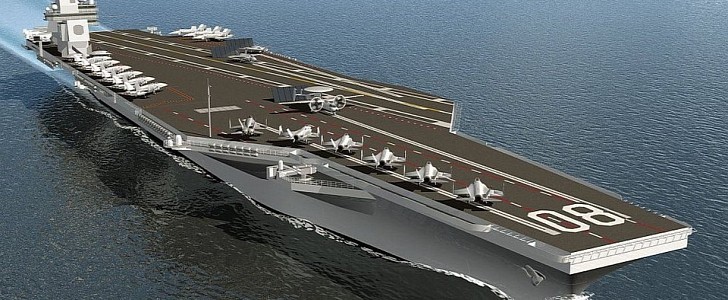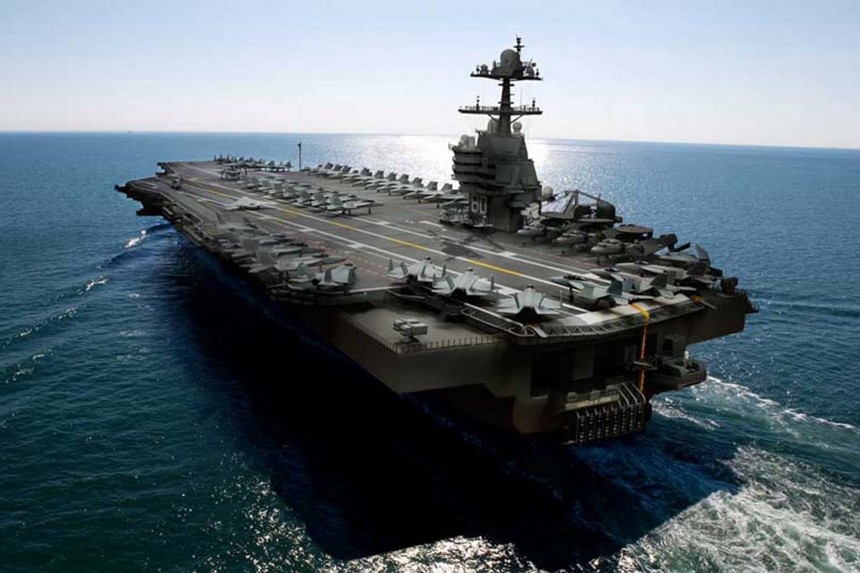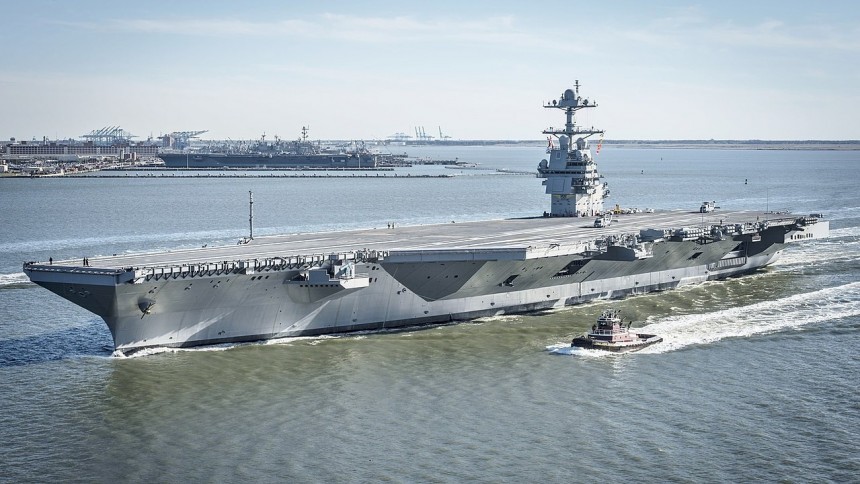Eight American warships have donned the name USS Enterprise in the last 250 years or so years. Of those, most are only aware of the existence of two. Of course, they're both flagship aircraft carriers.
One which slugged it out in the Pacific Ocean during World War Two, and another that took up its predecessor's mantle piece as one of the flagships of the U.S. Navy fleet during the relentless Cold War. But by the time this decade is out, another warship will sport the famed USS Enterprise moniker. Yet again, it's another aircraft carrier. As if it could be anything else at this point.
Say hello to CVN-80, the third in a distinguished line of Navy Aircraft carriers to bear the name. A Gerald Ford-class nuclear-powered leviathan is scheduled to operate in 2028 at the earliest. But the origins of America's next Big E aircraft carrier truly began back in 2012 with the decommissioning of CVN-65, the second Enterprise carrier.
At its decommissioning ceremony on December 1st of that year, it was announced by then Secretary of the Navy Ray Mabus that the USS Enterprise name would live on in the form of a brand new nuclear-powered supercarrier to not only passively replace CVN-65 but also directly replace the USS Dwight D. Eisenhower (CVN-69) in service since the mid-1970s.
Enterprise CVN-80 could very well replace the USS Dwight D Eisenhower as the flagship supercarrier of the mighty Carrier Strike Group 2, a role with which the latter has served since 2004. If this is the case, CVN-80 will be dedicating the bulk of its service to air superiority and ground force target neutralization in support of ground forces coordinated by the U.S. Army and Marine Corps as well as with air support from the USAF.
CVN-80 will also be the first American supercarrier in decades not to be named in honor of a major American historical figure. I.e., significant U.S. Presidents, admirals, generals, etc. The upcoming ship's first steel-cutting ceremony commenced on August 21st, 2017. With celebrity athletes like Simone Biles and Katie Ledecky present at the ceremony, it was clear CVN-80s commencement garnered more attention than the average cruiser, destroyer, or even submarine.
The ship is currently under construction by the Huntington Ingalls Industries company through their Newport News Shipbuilding division located, of course, at America's largest shipbuilding facility in Newport News, Virginia. A not at all insignificant portion of the metal slated for use on CVN-80 indeed comes from melted down bits and pieces of CVN-65.
There will even be a series of portholes originally installed on CV-6 due to be installed in CVN-80 at some point very soon. Powering this mighty ship will be a set of two state-of-the-art Bechtel A1B nuclear reactors. An evolution of the previous A4W reactors present on a number of U.S. Navy nuclear warships. With an estimated power output somewhere in the 700-megawatt range, it'll be at least a 25 percent improvement in power and efficiency over previous naval nuclear drivetrains.
Of course, some of this power will be radiated away as heat, meaning final power figures could measure in the area of 125 megawatts (168,000 hp) worth of electricity and 350,000 shaft horsepower (260 MW) from just one of the two reactors to power the ship's propellers in the water. Doing so while being smaller, lighter, and more compact than any sea-fairing nuclear reactor ever made. Opening up the potential for a great deal of maintenance, oversight, and due diligence synonymous with modern nuclear supercarriers to be reduced or eliminated.
With estimated dimensions of 1,106 feet (337 m) in length, a 134 foot (41 m) beam, and a 39 foot (12 m) draft, CVN-80's dimensions fit fairly comfortably into that of its predecessor CVN-65. Its performance figures are also believed to be fairly similar, with a top speed in excess of 33.6 knots (38.7 mph, 62.2 km/h) for both warships.
This being an American supercarrier, expect the new ship to carry a full suite of modern naval airplanes ranging from F/A-18F Super Hornets, F-35 Lightning IIs, E-2 Hawkeyes, V-22 Ospreys, and Sikorsky Super Stallion helicopters alongside a compliment of 4,660 sailors. Down nearly 1000 personnel compared to the maximum capacity of CVN-65, but still no less of a floating city paid for by the Navy. Expect CVN-80 to finish construction sometime during the middle of the 2020s, just in time for its scheduled deployment three or so years later.
Check back soon for more from Sea Month right here on autoevolution.
Say hello to CVN-80, the third in a distinguished line of Navy Aircraft carriers to bear the name. A Gerald Ford-class nuclear-powered leviathan is scheduled to operate in 2028 at the earliest. But the origins of America's next Big E aircraft carrier truly began back in 2012 with the decommissioning of CVN-65, the second Enterprise carrier.
At its decommissioning ceremony on December 1st of that year, it was announced by then Secretary of the Navy Ray Mabus that the USS Enterprise name would live on in the form of a brand new nuclear-powered supercarrier to not only passively replace CVN-65 but also directly replace the USS Dwight D. Eisenhower (CVN-69) in service since the mid-1970s.
Enterprise CVN-80 could very well replace the USS Dwight D Eisenhower as the flagship supercarrier of the mighty Carrier Strike Group 2, a role with which the latter has served since 2004. If this is the case, CVN-80 will be dedicating the bulk of its service to air superiority and ground force target neutralization in support of ground forces coordinated by the U.S. Army and Marine Corps as well as with air support from the USAF.
The ship is currently under construction by the Huntington Ingalls Industries company through their Newport News Shipbuilding division located, of course, at America's largest shipbuilding facility in Newport News, Virginia. A not at all insignificant portion of the metal slated for use on CVN-80 indeed comes from melted down bits and pieces of CVN-65.
There will even be a series of portholes originally installed on CV-6 due to be installed in CVN-80 at some point very soon. Powering this mighty ship will be a set of two state-of-the-art Bechtel A1B nuclear reactors. An evolution of the previous A4W reactors present on a number of U.S. Navy nuclear warships. With an estimated power output somewhere in the 700-megawatt range, it'll be at least a 25 percent improvement in power and efficiency over previous naval nuclear drivetrains.
Of course, some of this power will be radiated away as heat, meaning final power figures could measure in the area of 125 megawatts (168,000 hp) worth of electricity and 350,000 shaft horsepower (260 MW) from just one of the two reactors to power the ship's propellers in the water. Doing so while being smaller, lighter, and more compact than any sea-fairing nuclear reactor ever made. Opening up the potential for a great deal of maintenance, oversight, and due diligence synonymous with modern nuclear supercarriers to be reduced or eliminated.
This being an American supercarrier, expect the new ship to carry a full suite of modern naval airplanes ranging from F/A-18F Super Hornets, F-35 Lightning IIs, E-2 Hawkeyes, V-22 Ospreys, and Sikorsky Super Stallion helicopters alongside a compliment of 4,660 sailors. Down nearly 1000 personnel compared to the maximum capacity of CVN-65, but still no less of a floating city paid for by the Navy. Expect CVN-80 to finish construction sometime during the middle of the 2020s, just in time for its scheduled deployment three or so years later.
Check back soon for more from Sea Month right here on autoevolution.


